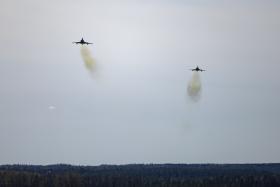With support from Typhoon fighter jets, Apache AH-64E attack helicopters and artillery, paratroopers on a major NATO exercise in Estonia have shown the firepower they can bring to bear.
On Exercise Swift Response, a battle camp for 3rd Battalion The Parachute Regiment Battlegroup (3 PARA BG) culminated in a 48-hour live fire mission to clear and hold a 3km-long trench system.
Under cover of darkness, troops were inserted by Chinook helicopters to assault the heavily fortified trenches at dawn. With enemy drones hovering overhead, and the paratroopers’ own drones flying forward to gather information, the soldiers painstakingly advanced through the trenches.
The 105mm Light Guns of 7th Parachute Regiment Royal Horse Artillery (7 Para RHA), 3 PARA’s 81mm mortars, and strafing runs from a Wildcat reconnaissance helicopters 12.7mm Heavy Machine Guns helped subdue enemy strong points. Evacuating simulated casualties and managing the resupply of ammunition added extra challenge.
After a chilly night in the trenches, troops then had to defend the positions they had captured, with 23 Parachute Engineer Regiment (23 Para Engr Regt) blasting trees to create natural fortifications.
3 PARA’s Private Matt Hames, a General Purpose Machine Gunner (GPMG), said: “In the trenches it’s very cramped, the front line is only a few soldiers wide, and you’ve just got to be extra switched on. A lot of the time I was holding long corridors with GPMG fire while the rest of the section were clearing side trenches and bunkers.
“I’m providing firepower to keep the enemies’ heads down and protect my mates. We all know our roles and each other, and it’s the team that sees you through.”
23 Para Engr Regt’s Sapper Will Coleman said: “We removed obstacles in the way of the infantry - we blew up barbed wire fortifications for the initial break-in, blew open bunkers, and cleared mines. We’re combat engineers, but we carry rifles and put rounds down when needed – and I did.”
Air support is coordinated by 7 Para RHA’s Joint Terminal Attack Controllers (JTAC), who have practiced working with Typhoons, Apaches, Wildcats and Puma Uncrewed Air Systems (UAS). Warrant Officer Class 2 Adam Colvin described the job as “doing air traffic control with high explosives. As a crossing point between operations on the ground and in the air, a JTAC is a real force multiplier,” he said. “When it’s all kicking off, the commander is looking for options and there are aircraft overhead, you have got the ability to drop the bomb that changes the situation. “There is a lot of pressure - you have to settle yourself, trust your training and experience and follow the procedures.”
3 PARA BG’s Commanding Officer Lieutenant Colonel Dave Mans said that the training had given his soldiers “a huge degree of realism and pressure” and praised their “controlled aggression and focus”.
“From Estonia, we do not need to look very far to see real battles being fought in trenches,” he said. “We need to develop, maintain, and excel at operating in these conditions. But also, the more we do at this scale and complexity, the better prepared we are for any environment. Training builds relationships, we learn how we react under pressure, and understand what our capabilities are to make the battlegroup as effective as possible, whatever it is asked to do.”
On Exercise Swift Response, 16 Air Assault Brigade Combat Team, the British Army’s global response force, is leading a force of more than 2,300 soldiers, sailors and aviators from four countries working together in Estonia. The training is about NATO airborne forces building their ability to respond together to crises.
It is part of 'Steadfast Defender 24', NATO’s largest military exercise since the Cold War, which involves approximately 90,000 troops from all 32 NATO allies.
Source:
Photos taken by Cpl Stone, British Army. Images and review sent via MOD Communications and Engagement officers.
Read More





Latest Comments
There are currently no comments for this content.
Add Comment
In order to add comments you must be registered with ParaData.
If you are currently a ParaData member please login.
If you are not currently a ParaData member but wish to get involved please register.